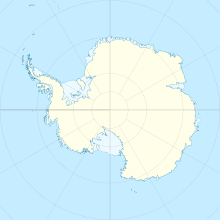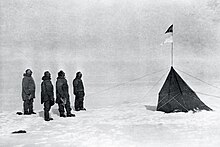Polheim (camp)
Coordinates: 90 ° 0 ′ 0 ″ S
Polheim is the camp founded on December 14, 1911 as part of the Norwegian Fram expedition by Roald Amundsen and his four companions immediately after arriving at the South Pole .
history
Reaching the South Pole and naming the camp site
Roald Amundsen and his companions Helmer Hanssen , Olav Bjaaland , Oscar Wisting and Sverre Hassel were the first people to reach the South Pole on December 14, 1911 as part of their Fram expedition. They called their camp set up in the immediate vicinity of the South Pole Polheim. After the Norwegian flag was set up at the campsite, Amundsen announced that this land would be called King Haakon VII Plateau. However, this name has not caught on - except in Norway. Today the plateau is mostly referred to as the polar plateau .
In order to avoid any doubts that the expedition had actually reached the South Pole, Amundsen attached particular importance to the most exact possible positioning. Because the theodolite he was carrying had been damaged during the trip, Amundsen made do with a sextant . He assumed that his instruments could determine the position of the South Pole to within one nautical mile . Nevertheless, Polheim was circled (“boxed”) in several marches in order to further increase the security of having entered the pole. A detailed examination of the measurements of the expedition members documented in the diaries later showed that Polheim was only about 1.5 miles from the South Pole and that the group had reached the South Pole very precisely with a deviation of only about 200 meters when circling the camp.
On December 18, 1911, Amundsen's expedition left Polheim. The group left the reserve tent they had carried at the South Pole. Amundsen expected that his competitor for the Austrian South Pole, the Englishman Robert Falcon Scott , would reach the pole shortly after him. So he left a message in the tent for Scott and a letter to King Haakon VII of Norway. The message asked Scott to deliver the letter to the King of Norway in case Amundsen's expedition did not return.
Since the “officially” photo camera of the expedition was defective, the only pictures of Polheim taken by the Norwegian expedition were taken with Olav Bjaaland's private camera.
The English expedition in Polheim
The English expedition , led by Robert F. Scott, reached the South Pole and with it Polheim about a month after the departure of Amundsen's group on January 18, 1912. Scott took - as Amundsen requested - the letters in the tent. Scott and his companions were killed on their way back from the South Pole. Both documents were later found on Scott's body.
The further fate of Polheim
It was only around 45 years after Scott's expedition had left Polheim that people should enter the South Pole again, namely on the occasion of the establishment of the Amundsen-Scott South Pole Station as part of the International Geophysical Year . In view of the precipitation in the form of snow during this time, nothing of Polheim and Amundsen's tent could be seen at that time. It has not yet been found.
Polheim is now probably buried several meters deep in the ice. In addition, the movement of the ice may have changed the original position of the camp significantly since 1911.
credentials
- ^ Contribution by Jan Gunnar on the homepage of the Norwegian-US Scientific Traverse of East Antarctica
- ^ O. Orheim: The present location of the tent that Roald Amundsen left behind at the South Pole in December 1911. Polar Record Vol. 47, pp. 268–270 (2011) ( abstract )


